The sun is not quite up, here along the river. From what I can see through my workroom window, the sky is slightly overcast, the light soft and shadowless. Redbirds in the cedar tangles are singing. A robin in the top of the dooryard box elder is swinging through his lyrical melody. And in the pool in front of the cottage, the Canada geese are honking belligerently at one another.
Today is my birthday…and I hope you'll forgive me for departing from the usual nature-based fare for a few self-reflective comments. Nothing earth-shattering, mind you; no unveiling of any great secrets; no imparting of timeless wisdom. Just a few observations on a green May morning while I sip my coffee and consider the day ahead.
There was a time in my late youth when I aspired to be wealthy, handsome, and wise—an erudite bon vivant man-of-the-world. I have failed miserably on every count. Instead of a sprawling mansion in the suburbs, I live in a small stone cottage beside a small, pastoral stream. You've only to look at my mug shot to see how badly I missed the second aspiration. As for wisdom…the more I've learned, the less I know. Moreover, I prefer wearing jeans, tee-shirts, and sneakers, eating in country cafés and trading friendly quips with those around, to sitting at the head table at the most exclusive clubs and establishments, exchanging societal gossip and perspicacious insights with the real "movers and shakers."
I also intended to pursue a life of swashbuckling adventure. While I've certainly had more than my share of adventures, feats of heroic derring-do have seldom occurred, and both damsels-in-distress and dragons needing slaying have proven to be in noticeably short supply. Mostly I've caught a lot of lovely fish from back-of-beyond wilderness streams where bears and eagles outnumbered people, and the stars at night almost came close enough to touch.
I have no regrets whatsoever about how things have turned out.
What I have learned is that life is a gift and death inevitable. Between this finite span, we live only in the here-and-now…and we can either squander or savor each precious moment. There is always a choice.
I know that honesty, decency, courage, and compassion mean more to me than any sort of wealth or power. I'd rather give than receive, because the surest way to enlarge you life is to share yourself. Sometimes, to really own something, you have to give it away.
I've learned the right path to follow is usually the hardest. I strive to live an honorable life, to follow the Golden Rule—and when I fail, I diminish and disappoint myself. Vengeance is never sweet. I'd rather be humble than proud.
It's better to love than to hate. When people love you, love them back. Tell them; show them. True friends are not all that common, but are one of life's greatest treasures. Friendship should always be reciprocal. Never miss an opportunity to let someone know how much you care about them. Nothing beats forgiveness and understanding. A warm hug is way better than a cold heart.
Finally, I know that God—not fate or self-determination—is the master of my life. I've tried it the other way and found life to be empty, worthless, and ultimately devoid of meaning. The physical and intellectual simply aren't enough; there is always a void. All the logic and rationalizing in the world didn't make it feel better; I couldn't deny or disbelieve it away.
God has been really good to me. I am here, having made it to another year, by His grace.
I am so grateful.
———————










































